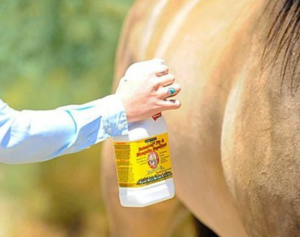Now that you have developed your Integrated Pest Management (IPM) program, it’s time to put it into action! Here are the four components of your IPM and their common use sites with some tips to help you optimize each for maximum fly control.
Biological control is the use of a beneficial organism to control a pest organism. Fly Predators are a unique blend of species that work together to optimize biological control for filth flies, which is a key component of any IPM program.
Spalding Labs will send you the ideal quantity of Fly Predators based on your situation. All you need to do is spread them in areas where flies reproduce — including places where there is or was fresh manure or other rotting organic matter — and Fly Predators will kill the flies before they emerge! You will want to spread your Fly Predators out in proportion to the amount of manure or rotting organic matter in each area.

If you have horses or other livestock in a pasture where the manure doesn’t dry out, you will want to spread your Fly Predators out in a grid pattern, shaking out a small portion every 75 feet.
For the barn, leave 5-10% of your Fly Predators in the bag and hang it in a breezeway. Remember, you might see most of your flies in the barn, but it is likely that only a few reproduced there.
Watch this video to learn how to use Fly Predators on your farm.
Cultural control includes any measures taken to disrupt the ideal living conditions of target pests. You can help reduce fly populations by incorporating good manure management practices — like hauling manure away, using a screen drag in pastures to help dry it out, using bedding materials that reduce fly production — or use drying agents in wet areas. You will want to implement cultural control measures throughout your property, paying special attention to manure piles, pastures, muck tubs, trash barrels, brush piles or anywhere else their is damp, rotting organic matter.
Mechanical control includes any means of physically removing pests. You can use fly traps, fans, and vacuums to remove or deter adult flies in the environment. These types of methods can easily be used in or immediately around the barn.
Chemical control includes the use of pesticides, repellents, insect growth regulators (IGRs), or any other chemical means of killing or repelling flies. Although Fly Predators will do most of the heavy lifting reducing pest fly populations, the targeted use of premise sprays and baits can help to further manage adult fly populations on key areas of the farm, including in the barn and around the property.

In addition to environmentally-safe Fly Predators, Spalding Labs’ Bye Bye Insect Fly Spray is an organic, all-natural way to repel flies. Bye Bye Insect’s active ingredients are primarily essential oils and their components, including geraniol, rosemary, citronella, peppermint and lemongrass. All ingredients meet EPA’s 25(b) Minimum Risk requirements and the rosemary, peppermint, vanillin and lemongrass components are food grade quality.
Optimizing each of the common use sites associated with your personalized IPM will help you maximize fly control. Don’t wait until your fly problem has already started to start — implement these changes now so when fly season starts, your operation is one step ahead of the flies.

